|
|
|
Sort Order |
|
|
|
Items / Page
|
|
|
|
|
|
|
| Srl | Item |
| 1 |
ID:
123064
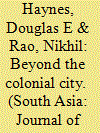

|
|
|
|
|
| Publication |
2013.
|
| Summary/Abstract |
It was long customary to begin essays on the historiography of cities in South Asia by mentioning the low level of scholarly interest once given to the study of urban pasts; 2 but a major corpus of work on this subject certainly now exists. In our view, the most important shortcomings of the existing body of scholarship now lie less in their neglect of historical urbanism than in the relative inattention given to a particular phase of urban history: the middle decades of the twentieth century. The historiography of South Asian cities has concentrated highly on what might be called 'the long nineteenth century', 3 a phase lasting from the establishment of British rule (which varied according to the region being discussed) to some point during the early twentieth century. Many of the richest works in the field confine themselves completely to nineteenth-century developments 4 or begin sometime during the late nineteenth century, edge into the initial decades of the twentieth century, and then end at some point in the 1920s or 1930s.
|
|
|
|
|
|
|
|
|
|
|
|
|
|
|
|
| 2 |
ID:
190675
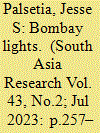

|
|
|
|
|
| Summary/Abstract |
Gas lighting, part of a re-envisioning of cities as modern metropoles, was one of the first ‘modern’ technologies implemented in nineteenth century Bombay. The debates over the implementation of gas light to illuminate the streets of Bombay have largely been overlooked in the history and historiography of colonial Bombay. Yet, the illumination of Bombay’s public streets with gas light was an important turning point in the transition of Bombay from a provincial outpost to a modern city. The article examines the related debates, presents the illumination of colonial Bombay with gas light as a metaphor for the emergence of the modern city and depicts how new processes regarding civic planning and development emerged from this gas light debate, which ultimately made the implementation of electrical light and other aspects of modern city life possible.
|
|
|
|
|
|
|
|
|
|
|
|
|
|
|
|
| 3 |
ID:
188403
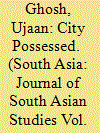

|
|
|
|
|
| Summary/Abstract |
The mid twentieth-century Bengali ghost story has a distinct urban form. From haunting Gothic mansions, ominous bungalows and thickets of trees, the ghosts of mid twentieth-century fiction show up in the streets of Calcutta, on motorised omnibuses, in urban movie theatres and even selling cocaine in the docks of the city. In this paper, I explore why Bengali ghost stories in the twentieth century predominantly choose the city as a motif to situate their hauntings. I analyse two spectral texts from the mid twentieth century, ‘Kankal Sarathi (The Skeleton Chauffeur)’ by Hemendra Kumar Ray (1888–1963) and ‘Andhakre (In Darkness)’ by Sharadindu Bandyopadhyay (1899–1970), and juxtapose them alongside the official urban archive. Significant changes took place in Calcutta’s urban planning at the turn of the twentieth century. Committed to ‘improving’ the city, planners sought large-scale demolitions of existing buildings, which resulted in massive displacement of individuals and communities. Historians have recorded the deep disquiet these changes induced in the city’s inhabitants. What I demonstrate are the ways in which ghost stories responded to these infrastructural alterities. Spectral narratives emerged as a new literary strategy through which the city’s new journey towards infrastructural modernity was critiqued. The larger methodological question I wish to explore is whether it is possible to treat the genre of horror as an extended archive of historical inquiry.
|
|
|
|
|
|
|
|
|
|
|
|
|
|
|
|
| 4 |
ID:
089386
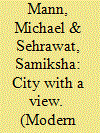

|
|
|
|
|
| Publication |
2009.
|
| Summary/Abstract |
Despite the contemporary importance of the Ridge forest to the city of Delhi as its most important 'green lung', the concept of urban forestry has been explored neither by urban historians studying Delhi nor by environmental historians. This article places the colonial efforts to plant a forest on the Delhi Ridge from 1883 to 1913 within the context of the gradual deforestation of the countryside around Delhi and the local colonial administration's preoccupation with encouraging arboriculture. This project of colonial forestry prioritized the needs of the white colonizers living in Delhi, while coming into conflict repeatedly with indigenous peasants. With the decision to transfer the capital to Delhi in 1911, the afforestation of the Delhi Ridge received a further stimulus. Town planners' visions of a building the capital city of New Delhi were meant to assert the grandeur of British rule through imposing buildings, with the permanence of the British in India being emphasised by the strategic location of the ruins of earlier empires within the city. The principles of English landscape gardening inspired the planning of New Delhi, with the afforestation of the Delhi Ridge being undertaken to provide a verdant backdrop for-the Government House and the Secretariat-the administrative centre of British government in India. Imperial notions of landscaping, which were central to the afforestation of the Delhi Ridge epitomised colonial rule and marginalized Indians.
|
|
|
|
|
|
|
|
|
|
|
|
|
|
|
|
| 5 |
ID:
193126
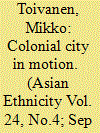

|
|
|
|
|
| Summary/Abstract |
This paper examines attempts by colonial authorities in nineteenth-century Singapore and Batavia (now Jakarta) to employ ceremonial processions to manage the ethnic diversity of these two major colonial capitals. Public spectacles formed a key forum for the reinforcement of ethnic categories and the negotiation of inter-community relations in the context of the colonial city. The paper looks at two case studies: the procession on the occasion of the arrival of governor-general Jan Jacob Rochussen in Batavia in 1845, and a second one celebrating the Duke of Edinburgh’s visit in Singapore in 1869. The analysis shows how these events attempted to fix ethnic categories spatially on the maps of the respective cities. Comparing the two events to a Malay account of the 1864 Muharram celebrations, the article also analyses the different ways that official and community-led processions employed mobility, visuality and sound to represent ethnicity and inter-community relations or hierarchies.
|
|
|
|
|
|
|
|
|
|
|
|
|
|
|
|
| 6 |
ID:
166764
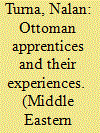

|
|
|
|
|
| Summary/Abstract |
In this article, I analyze craft and trade apprentices in the late Ottoman Empire in order to add a new dimension to the existing literature on guilds and artisans. Rather than presenting an ideal picture, I discuss the apprentices' actions and experiences, which I argue did not take place in isolation.
First, I briefly discuss Ottoman guilds and artisans, including a literature review, define and explain both the system of apprenticeship and who apprentices were.
|
|
|
|
|
|
|
|
|
|
|
|
|
|
|
|
| 7 |
ID:
159008
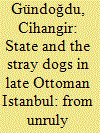

|
|
|
|
|
| Summary/Abstract |
The present article situates the systemic efforts to annihilate stray dogs within the wider picture of Ottoman modernizing reforms in the nineteenth century. The period under investigation witnessed an increasing desire on the part of the modern Ottoman state to control and reform disenfranchised human and animal groups, which were believed to jeopardize public order, security and hygiene. These groups – beggars, orphans and the unemployed – were identified as actors irreconcilable with the modern image that the reforming bureaucracy and modernizing elites sought to project. In the face of increasing challenges from European powers, they were the epitome of underdevelopment and backwardness. Ottoman elites and official authorities therefore proposed and implemented institutional measures in the form of forced labor, reformatories or deportation to reform the conditions of these groups, segregate them from the greater public and discipline them. In the modern period, along with the proposals that called for the removal of dogs, modernizing intellectuals and professionals proposed alternative plans to render non-human animals beneficial to human needs and the modern state's expectations.
|
|
|
|
|
|
|
|
|
|
|
|
|
|
|
|
| 8 |
ID:
164901
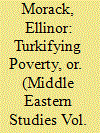

|
|
|
|
|
| Summary/Abstract |
This article shows that ‘Turkification’, a term widely used by historians of modern Turkey to refer to the forced transfer of property from Christian into Muslim hands, ought to be conceptualized not only in the sense of ‘enrichment’ but also, with regard to the working classes, as a process in which Muslim people inherited the poverty of their Christian predecessors. Taking İzmir as a case in point, the article first describes the plight of the overwhelmingly Christian working class prior to 1922. It then studies reports and editorials that discussed the economic and social situation in İzmir in the years 1923 to 1926, after the Turkish victory and forced migration of her Christian population. Over the course of these years, İzmir experienced a serious economic crisis, and bread prices reached levels that led to widespread undernourishment and hunger among the cityʼs poor. Agricultural production was lagging behind pre-war levels, and positive effects of ‘Turkificationʼ policies were failing to materialize. By analyzing the contemporary journalistsʼ attempts at explaining the crisis, but also pointing out national and transnational factors that they were probably unaware of, the article makes an original contribution to the economic and social history of early republican Turkey.
|
|
|
|
|
|
|
|
|
|
|
|
|
|
|
|
|
|
|
|
|